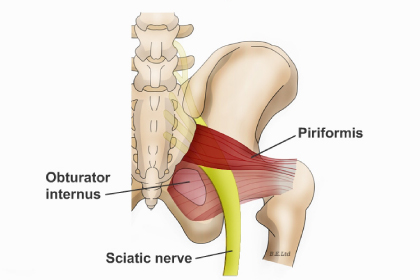[gap height=”30″]Sciatica Due to Piriformis Syndrome
Sciatica is a common condition which occurs when the sciatic nerve becomes pinched or irritated. As discussed in the previous two articles this most commonly occurs in lower back due to a disc herniation or spinal stenosis. However, the sciatic nerve can also become compressed by the muscles in the hip, a condition known as piriformis syndrome.
Sciatica due to piriformis syndrome is often misdiagnosed, which is a major problem as treatment will be focused at the back, not the piriformis. So in this third and final article of our sciatica series I will discuss piriformis syndrome.
What is Sciatica Due to Piriformis Syndrome
The piriformis is an important hip muscle that is commonly plays a key role in controlling and stabilizing the hip. While piriformis problems can often lead to hip pain, it can also lead to sciatica. This is because the sciatic nerve passes directly beneath the piriformis muscle. Under normal circumstances the sciatic nerve should be able to move and slide underneath the muscle.
However if the piriformis becomes tight or if scar tissue adhesions develop between the sciatic nerve and piriformis, the sciatic nerve can become trapped underneath the piriformis. As this happens the sciatic nerve can become compressed and irritated and eventually symptoms can develop into the leg along the path of the nerve.

Treatment for Sciatica Due to Piriformis Syndrome
While the symptoms associated with sciatica due to piriformis syndrome may be similar those seen with sciatica due to disc injury or sciatica due to spinal stenosis it cannot be treated the same. The problem is in the piriformis muscle of the hip, not in the joints of the lower back.
We have found the best way to sciatica due to piriformis syndrome is with a specialized type of soft tissue treatment known as Active Release Technqiues (or ART for short).
What makes ART different from other treatments is that it is designed to identify and address scar tissue adhesions that are interfering with the normal function of the body. With respect to Piriformis syndrome the goal is to 1) break-up restrictive scar tissue adhesions around the sciatic nerve and piriformis, and 2) restore normal sliding of the sciatica under the piriformis muscle. (you can learn more about Active Release Techniques here)
How Long Does it Take to Treat Sciatica Due to Piriformis Syndrome?
One of the best things about ART is how fast it can get results. Each treatment takes about 15 minutes, and we usually find a significant improvement can be gained in just 4-5 treatments – even in cases of long-standing symptoms that have not fully responded to other treatment approaches.
Get Relief From Sciatica Due to Piriformis Syndrome
To book an appointment to receive ART treatment for your sciatica due to piriformis syndrome simply contact our office. For more information you can call us or send us an email and one of our doctors will be happy to get back to you.
